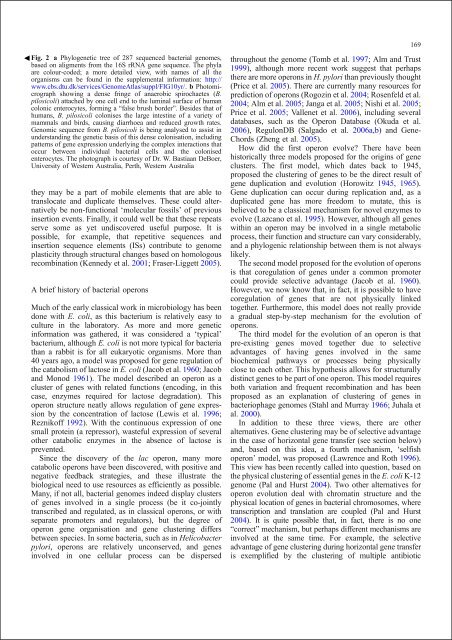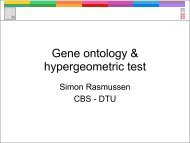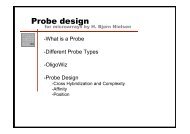Computational tools and Interoperability in Comparative ... - CBS
Computational tools and Interoperability in Comparative ... - CBS
Computational tools and Interoperability in Comparative ... - CBS
You also want an ePaper? Increase the reach of your titles
YUMPU automatically turns print PDFs into web optimized ePapers that Google loves.
3Fig. 2 a Phylogenetic tree of 287 sequenced bacterial genomes,<br />
based on aligments from the 16S rRNA gene sequence. The phyla<br />
are colour-coded; a more detailed view, with names of all the<br />
organisms can be found <strong>in</strong> the supplemental <strong>in</strong>formation: http://<br />
www.cbs.dtu.dk/services/GenomeAtlas/suppl/FIG10yr/. b Photomicrograph<br />
show<strong>in</strong>g a dense fr<strong>in</strong>ge of anaerobic spirochaetes (B.<br />
pilosicoli) attached by one cell end to the lum<strong>in</strong>al surface of human<br />
colonic enterocytes, form<strong>in</strong>g a “false brush border”. Besides that of<br />
humans, B. pilosicoli colonises the large <strong>in</strong>test<strong>in</strong>e of a variety of<br />
mammals <strong>and</strong> birds, caus<strong>in</strong>g diarrhoea <strong>and</strong> reduced growth rates.<br />
Genomic sequence from B. pilosicoli is be<strong>in</strong>g analysed to assist <strong>in</strong><br />
underst<strong>and</strong><strong>in</strong>g the genetic basis of this dense colonisation, <strong>in</strong>clud<strong>in</strong>g<br />
patterns of gene expression underly<strong>in</strong>g the complex <strong>in</strong>teractions that<br />
occur between <strong>in</strong>dividual bacterial cells <strong>and</strong> the colonised<br />
enterocytes. The photograph is courtesy of Dr. W. Bastiaan DeBoer,<br />
University of Western Australia, Perth, Western Australia<br />
they may be a part of mobile elements that are able to<br />
translocate <strong>and</strong> duplicate themselves. These could alternatively<br />
be non-functional ‘molecular fossils’ of previous<br />
<strong>in</strong>sertion events. F<strong>in</strong>ally, it could well be that these repeats<br />
serve some as yet undiscovered useful purpose. It is<br />
possible, for example, that repetitive sequences <strong>and</strong><br />
<strong>in</strong>sertion sequence elements (ISs) contribute to genome<br />
plasticity through structural changes based on homologous<br />
recomb<strong>in</strong>ation (Kennedy et al. 2001; Fraser-Liggett 2005).<br />
A brief history of bacterial operons<br />
Much of the early classical work <strong>in</strong> microbiology has been<br />
done with E. coli, as this bacterium is relatively easy to<br />
culture <strong>in</strong> the laboratory. As more <strong>and</strong> more genetic<br />
<strong>in</strong>formation was gathered, it was considered a ‘typical’<br />
bacterium, although E. coli is not more typical for bacteria<br />
than a rabbit is for all eukaryotic organisms. More than<br />
40 years ago, a model was proposed for gene regulation of<br />
the catabolism of lactose <strong>in</strong> E. coli (Jacob et al. 1960; Jacob<br />
<strong>and</strong> Monod 1961). The model described an operon as a<br />
cluster of genes with related functions (encod<strong>in</strong>g, <strong>in</strong> this<br />
case, enzymes required for lactose degradation). This<br />
operon structure neatly allows regulation of gene expression<br />
by the concentration of lactose (Lewis et al. 1996;<br />
Reznikoff 1992). With the cont<strong>in</strong>uous expression of one<br />
small prote<strong>in</strong> (a repressor), wasteful expression of several<br />
other catabolic enzymes <strong>in</strong> the absence of lactose is<br />
prevented.<br />
S<strong>in</strong>ce the discovery of the lac operon, many more<br />
catabolic operons have been discovered, with positive <strong>and</strong><br />
negative feedback strategies, <strong>and</strong> these illustrate the<br />
biological need to use resources as efficiently as possible.<br />
Many, if not all, bacterial genomes <strong>in</strong>deed display clusters<br />
of genes <strong>in</strong>volved <strong>in</strong> a s<strong>in</strong>gle process (be it co-jo<strong>in</strong>tly<br />
transcribed <strong>and</strong> regulated, as <strong>in</strong> classical operons, or with<br />
separate promoters <strong>and</strong> regulators), but the degree of<br />
operon gene organisation <strong>and</strong> gene cluster<strong>in</strong>g differs<br />
between species. In some bacteria, such as <strong>in</strong> Helicobacter<br />
pylori, operons are relatively unconserved, <strong>and</strong> genes<br />
<strong>in</strong>volved <strong>in</strong> one cellular process can be dispersed<br />
169<br />
throughout the genome (Tomb et al. 1997; Alm <strong>and</strong> Trust<br />
1999), although more recent work suggest that perhaps<br />
there are more operons <strong>in</strong> H. pylori than previously thought<br />
(Price et al. 2005). There are currently many resources for<br />
prediction of operons (Rogoz<strong>in</strong> et al. 2004; Rosenfeld et al.<br />
2004; Alm et al. 2005; Janga et al. 2005; Nishi et al. 2005;<br />
Price et al. 2005; Vallenet et al. 2006), <strong>in</strong>clud<strong>in</strong>g several<br />
databases, such as the Operon Database (Okuda et al.<br />
2006), RegulonDB (Salgado et al. 2006a,b) <strong>and</strong> Gene-<br />
Chords (Zheng et al. 2005).<br />
How did the first operon evolve? There have been<br />
historically three models proposed for the orig<strong>in</strong>s of gene<br />
clusters. The first model, which dates back to 1945,<br />
proposed the cluster<strong>in</strong>g of genes to be the direct result of<br />
gene duplication <strong>and</strong> evolution (Horowitz 1945, 1965).<br />
Gene duplication can occur dur<strong>in</strong>g replication <strong>and</strong>, as a<br />
duplicated gene has more freedom to mutate, this is<br />
believed to be a classical mechanism for novel enzymes to<br />
evolve (Lazcano et al. 1995). However, although all genes<br />
with<strong>in</strong> an operon may be <strong>in</strong>volved <strong>in</strong> a s<strong>in</strong>gle metabolic<br />
process, their function <strong>and</strong> structure can vary considerably,<br />
<strong>and</strong> a phylogenic relationship between them is not always<br />
likely.<br />
The second model proposed for the evolution of operons<br />
is that coregulation of genes under a common promoter<br />
could provide selective advantage (Jacob et al. 1960).<br />
However, we now know that, <strong>in</strong> fact, it is possible to have<br />
coregulation of genes that are not physically l<strong>in</strong>ked<br />
together. Furthermore, this model does not really provide<br />
a gradual step-by-step mechanism for the evolution of<br />
operons.<br />
The third model for the evolution of an operon is that<br />
pre-exist<strong>in</strong>g genes moved together due to selective<br />
advantages of hav<strong>in</strong>g genes <strong>in</strong>volved <strong>in</strong> the same<br />
biochemical pathways or processes be<strong>in</strong>g physically<br />
close to each other. This hypothesis allows for structurally<br />
dist<strong>in</strong>ct genes to be part of one operon. This model requires<br />
both variation <strong>and</strong> frequent recomb<strong>in</strong>ation <strong>and</strong> has been<br />
proposed as an explanation of cluster<strong>in</strong>g of genes <strong>in</strong><br />
bacteriophage genomes (Stahl <strong>and</strong> Murray 1966; Juhala et<br />
al. 2000).<br />
In addition to these three views, there are other<br />
alternatives. Gene cluster<strong>in</strong>g may be of selective advantage<br />
<strong>in</strong> the case of horizontal gene transfer (see section below)<br />
<strong>and</strong>, based on this idea, a fourth mechanism, ‘selfish<br />
operon’ model, was proposed (Lawrence <strong>and</strong> Roth 1996).<br />
This view has been recently called <strong>in</strong>to question, based on<br />
the physical cluster<strong>in</strong>g of essential genes <strong>in</strong> the E. coli K-12<br />
genome (Pal <strong>and</strong> Hurst 2004). Two other alternatives for<br />
operon evolution deal with chromat<strong>in</strong> structure <strong>and</strong> the<br />
physical location of genes <strong>in</strong> bacterial chromosomes, where<br />
transcription <strong>and</strong> translation are coupled (Pal <strong>and</strong> Hurst<br />
2004). It is quite possible that, <strong>in</strong> fact, there is no one<br />
“correct” mechanism, but perhaps different mechanisms are<br />
<strong>in</strong>volved at the same time. For example, the selective<br />
advantage of gene cluster<strong>in</strong>g dur<strong>in</strong>g horizontal gene transfer<br />
is exemplified by the cluster<strong>in</strong>g of multiple antibiotic









